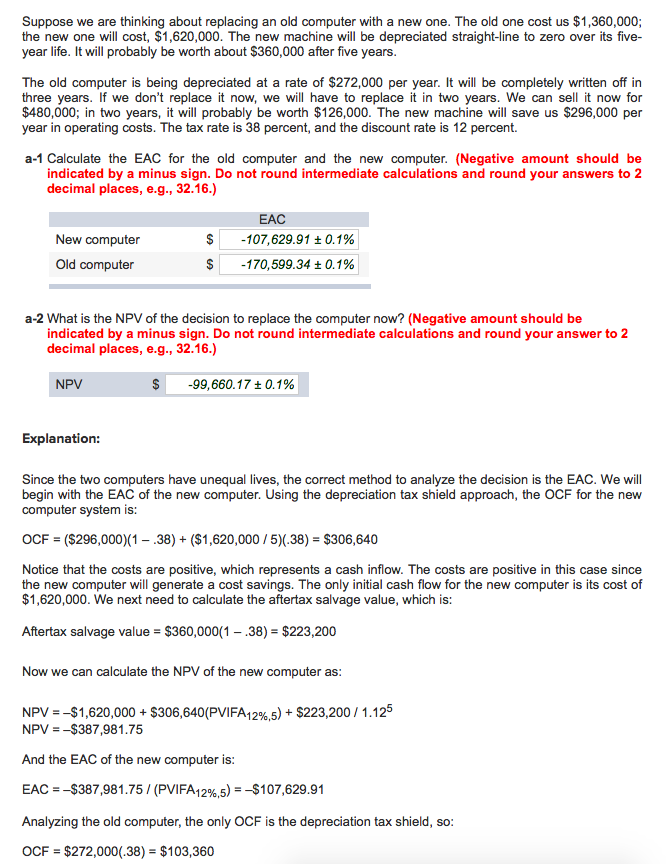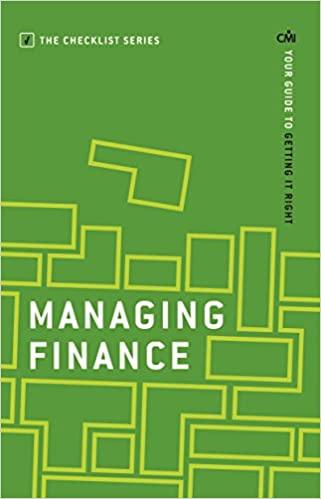| Suppose we are thinking about replacing an old computer with a new one. The old one cost us $1,310,000; the new one will cost, $1,570,000. The new machine will be depreciated straight-line to zero over its five-year life. It will probably be worth about $310,000 after five years. |
| The old computer is being depreciated at a rate of $262,000 per year. It will be completely written off in three years. If we dont replace it now, we will have to replace it in two years. We can sell it now for $430,000; in two years, it will probably be worth $121,000. The new machine will save us $291,000 per year in operating costs. The tax rate is 40 percent, and the discount rate is 11 percent. |
| a1 | Calculate the EAC for the old computer and the new computer. (Negative amount should be indicated by a minus sign. Do not round intermediate calculations and round your answers to 2 decimal places, e.g., 32.16.) | a2 | What is the NPV of the decision to replace the computer now? (Negative amount should be indicated by a minus sign. Do not round intermediate calculations and round your answer to 2 decimal places, e.g., 32.16.) | |
BELOW IS AN EXAMPLE PROBLEM THAT I ALSO COULD NOT SOLVE


Suppose we are thinking about replacing an old computer with a new one. The old one cost us $1,360,000; the new one will cost, $1,620,000. The new machine will be depreciated straight-line to zero over its five year life. It will probably be worth about $360,000 after five years The old computer is being depreciated at a rate of $272,000 per year. It will be completely written off in three years. If we don't replace it now, we will have to replace it in two years. We can sell it now for $480,000; in two years, it will probably be worth $126,000. The new machine wi save us $296,000 per year in operating costs. The tax rate is 38 percent, and the discount rate is 12 percent a-1 Calculate the EAC for the old computer and the new computer. (Negative amount should be indicated by a minus sign. Do not round intermediate calculations and round your answers to 2 decimal places, e.g., 32.16.) EAC. New computer 107,629.91 t 0.1% Old computer 170,599.34 t 0.1% a-2 What is the NPV of the decision to replace the computer now? (Negative amount should be indicated by a minus sign. Do not round intermediate calculations and round your answer to 2 decimal places, e.g., 32.16.) NPV 99,660.17 t 0.1% Explanation: Since the two computers have unequal lives, the correct method to analyze the decision is the EAC. We will begin with the EAC of the new computer. Using the depreciation tax shield approach, the OCF for the new computer system OCF E ($296,000) (1 38) ($1,620,000 /5)(.38) $306,640 Notice that the costs are positive, which represents a cash inflow. The costs are positive in this case since the new computer will generate a cost savings. The only initial cash flow for the new computer is its cost of $1,620,000. We next need to calculate the aftertax salvage value, which is After tax salvage value E $360,000(1 .38) $223,200 Now we can calculate the NPV of the new computer as: NPV -$1,620,000 12%,5) $223,200 1.12 NPV -$387,981.75 And the EAC of the new computer is: EAC --$387,981.75 12%,5) -$107,629.91 Analyzing the old computer, the only OCF is the depreciation tax shield, so OCF E $272,000(.38) $103,360








